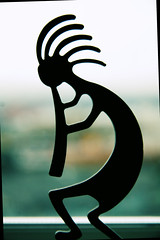
Kokopelli likeness varies almost as much as his legends. He is usually illustrated as a humpbacked flute player often with a huge phallus and antenna-like protrusions on his head. The first identified images of him appear on Hohokam pottery dated to sometime between 750 A.D and 850 A.D.
According to the Hopi myth, Kokopelli carries unborn children on his back and distributes them to women. He often takes part in rituals relating to marriage, and Kokopelli himself is sometimes depicted with a consort, a woman called Kokopelli-mana by the Hohokam and Hopi. At San Idelfonso, a Pueblo Village, Kokopelli is thought to be a wandering minstrel with a sack of songs on his back who trades old songs for new. An according to Navajo legend, Kokopelli is a God of harvest and plenty. It is thought that his sack was made of clouds full of rainbows or seeds.
Kokopelli may have originally been a representation of ancient Aztec traders, known as pochtecas, who traveled to the Southwest from northern Mesoamerica. These traders brought their goods in sacks slung across their backs and this sack may have evolved into Kokopelli's familiar hump. These traders also used their flutes to announce themselves as friendly as they approached a settlement. This origin is still in doubt, however, since the first known images of Kokopelli predate the major era of Aztec-Anasazi trade by several hundred years.
Another theory is that Kokopelli is actually an anthropomorphic insect. Many of the earliest depictions of Kokopelli make him very insect-like in appearance. The name "Kokopelli" may be a combination of "Koko", another Hopi and Zuni deity, and "pelli", the Hopi and Zuni word for the desert robber fly, an insect with a prominent proboscis and a rounded back, which is also noted for its zealous sexual proclivities. A more recent etymology is that Kokopelli means literally "kachina hump". Because the Hopi were the tribe from whom the Spanish explorers first learned of the god, their name is the one most commonly used.
A similar humpbacked figure is found in artifacts of the Mississippian culture of the U.S. southeast. Approximately 1200 to 1400 AD, water vessels were crafted in the shape of a humpbacked woman. These forms may represent a cultural heroine or founding ancestor, and may also reflect concepts related to the life-giving blessings of water and fertility.
Kokopelli is one of the most widely recognized images today. His images can be found on anything such as T-shirts, ball caps, key chains and so many more things. A bicycle trail between Grand Junction, Colorado and Moab, Utah, is now known as the Kokopelli Trail.
Native American




0 komentar
Post a Comment